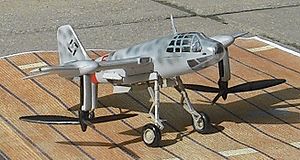1940s German tiltrotor aircraft project
| Focke-Achgelis Fa 269
|

|
| model shown
|
| Role
|
VTOL aircraft project Type of aircraft
|
| Manufacturer
|
Focke-Achgelis
|
| Designer
|
Heinrich Focke
|
| First flight
|
none
|
| Primary user
|
none
|
| Number built
|
0
|
The Focke-Achgelis Fa 269 was a tiltrotor VTOL aircraft project designed by Henrich Focke.
Development
Conceived as a single-seat fighter, the Fa 269 project resulted from a design study order issued by the Reich Air Ministry to Focke-Achgelis in 1941. The order called for a local defence fighter which would combine the VTOL capabilities of a helicopter with the speed and economy of a conventional fixed-wing aircraft.
A large amount of wind tunnel testing was undertaken, along with work on gearboxes, drives and power-pivoting mechanisms, and a full-scale mock-up of the aircraft was built to demonstrate the VTOL concept, but much of this was destroyed by Allied bombing raids and all work was shelved in 1944,[1] when Focke-Achgelis estimated that there was little likelihood of a practical prototype being available before 1947.
Design
A mid-wing monoplane, the Fa 269 was to have been powered by a single BMW 801 air-cooled radial engine buried in the fuselage behind the cockpit, which was to have driven transverse drive shafts in the leading edges of the fixed wing, the shafts turning three-bladed rotors via synchronised gearboxes. The plane of rotation of the rotors would have been capable of being swivelled through 80° using angled extension shafts.
It was proposed that the Fa 269 would adopt a high angle of attack when at rest using extremely long undercarriage units. For vertical take-off, the rotors would be lowered till their plane of rotation was parallel with the ground. For translation to conventional flight following take-off, the extension shafts were to pivot to the rear, the rotors then behaving as pusher propellers.[2]
Specifications (Fa 269)
Data from Air International, January 1975
General characteristics
- Crew: 1
- Length: 8.93 m (29 ft 3 in)
- Wingspan: 10 m (32 ft 9 in)
- Powerplant: 1 × BMW 801 14-cylinder radial piston
Performance
- Maximum speed: 570 km/h (354 mph, 308 kn)
Armament
